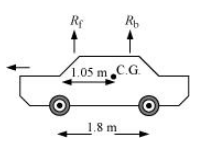Question.
A car weighs 1800 kg. The distance between its front and back axles is 1.8 m. Its centre of gravity is 1.05 m behind the front axle. Determine the force exerted by the level ground on each front wheel and each back wheel.
A car weighs 1800 kg. The distance between its front and back axles is 1.8 m. Its centre of gravity is 1.05 m behind the front axle. Determine the force exerted by the level ground on each front wheel and each back wheel.
solution:
Mass of the car, m = 1800 kg
Distance between the front and back axles, d = 1.8 m
Distance between the C.G. (centre of gravity) and the back axle = 1.05 m
The various forces acting on the car are shown in the following figure.

$R_{\mathrm{f}}$ and $R_{\mathrm{b}}$ are the forces exerted by the level ground on the front and back wheels respectively.
At translational equilibrium:
$R_{\mathrm{f}}+R_{\mathrm{b}}=m g$
$=1800 \times 9.8$
$=17640 \mathrm{~N} \ldots(i)$
For rotational equilibrium, on taking the torque about the C. G., we have:
$R_{\mathrm{f}}(1.05)=R_{\mathrm{b}}(1.8-1.05)$
$R_{\mathrm{f}} \times 1.05=R_{\mathrm{b}} \times 0.75$
$\frac{R_{\mathrm{f}}}{R_{\mathrm{b}}}=\frac{0.75}{1.05}=\frac{5}{7}$
$\frac{R_{\mathrm{b}}}{R_{\mathrm{f}}}=\frac{7}{5}$
$R_{\mathrm{b}}=1.4 R_{\mathrm{f}}$ $\ldots(i i)$
Solving equations $(i)$ and $(i i)$, we get:
$1.4 R_{\mathrm{f}}+R_{\mathrm{f}}=17640$
$R_{\mathrm{f}}=\frac{17640}{2.4}=7350 \mathrm{~N}$
$\therefore R_{b}=17640-7350=10290 \mathrm{~N}$
Therefore, the force exerted on each front wheel $=\frac{7350}{2}=3675 \mathrm{~N}$, and
The force exerted on each back wheel $=\frac{10290}{2}=5145 \mathrm{~N}$
Mass of the car, m = 1800 kg
Distance between the front and back axles, d = 1.8 m
Distance between the C.G. (centre of gravity) and the back axle = 1.05 m
The various forces acting on the car are shown in the following figure.

$R_{\mathrm{f}}$ and $R_{\mathrm{b}}$ are the forces exerted by the level ground on the front and back wheels respectively.
At translational equilibrium:
$R_{\mathrm{f}}+R_{\mathrm{b}}=m g$
$=1800 \times 9.8$
$=17640 \mathrm{~N} \ldots(i)$
For rotational equilibrium, on taking the torque about the C. G., we have:
$R_{\mathrm{f}}(1.05)=R_{\mathrm{b}}(1.8-1.05)$
$R_{\mathrm{f}} \times 1.05=R_{\mathrm{b}} \times 0.75$
$\frac{R_{\mathrm{f}}}{R_{\mathrm{b}}}=\frac{0.75}{1.05}=\frac{5}{7}$
$\frac{R_{\mathrm{b}}}{R_{\mathrm{f}}}=\frac{7}{5}$
$R_{\mathrm{b}}=1.4 R_{\mathrm{f}}$ $\ldots(i i)$
Solving equations $(i)$ and $(i i)$, we get:
$1.4 R_{\mathrm{f}}+R_{\mathrm{f}}=17640$
$R_{\mathrm{f}}=\frac{17640}{2.4}=7350 \mathrm{~N}$
$\therefore R_{b}=17640-7350=10290 \mathrm{~N}$
Therefore, the force exerted on each front wheel $=\frac{7350}{2}=3675 \mathrm{~N}$, and
The force exerted on each back wheel $=\frac{10290}{2}=5145 \mathrm{~N}$
Click here to get exam-ready with eSaral
For making your preparation journey smoother of JEE, NEET and Class 8 to 10, grab our app now.
